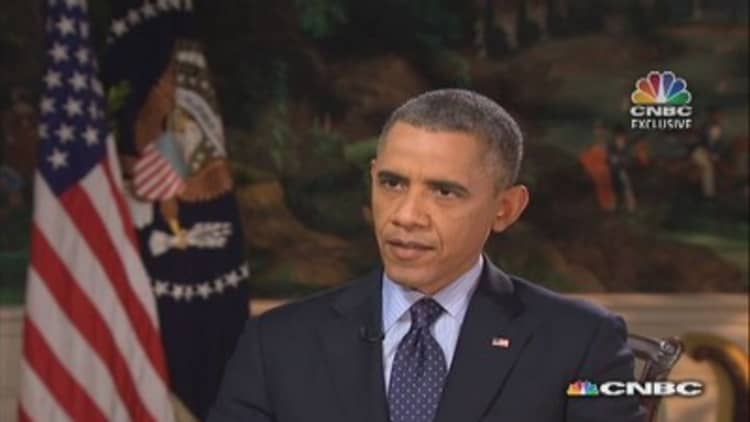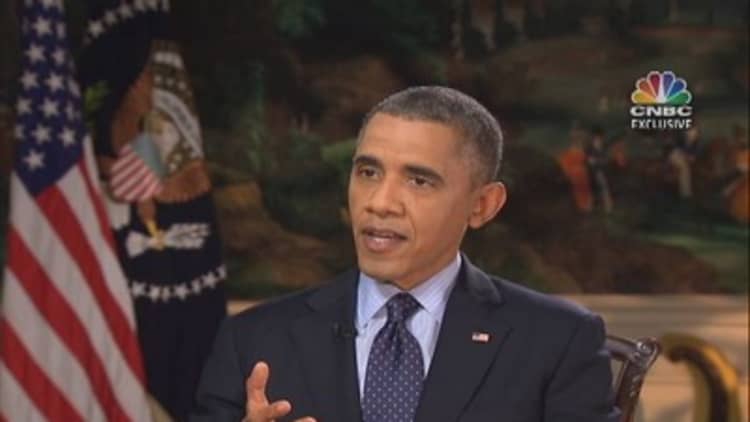With Washington preoccupied by the government shutdown, Wall Street is shifting its attention to an even more worrisome situation: the possibility that the government could run out of money within the next few weeks, forcing an unprecedented default on its debt.
The Treasury said last week that Congress had until Oct. 17 to raise the limit on how much the federal government could borrow or risk leaving the country on the precipice of default. If the debt ceiling is not raised by then, the Treasury estimates it will be left with about only $30 billion in cash, which would be used up in a matter of days.
As a result, economists and investors have quietly begun to explore the options the White House might have in the event Congress fails to act.
(Read more: Obama: 'I am exasperated' over gridlock)
The most widely discussed strategy would be for President Obama to invoke authority under the 14th Amendment and essentially order the federal government to keep borrowing, an option that was endorsed by former President Bill Clinton during an earlier debt standoff in 2011.

And in recent days, prominent Democrats like Senator Max Baucus, chairman of the Senate Finance Committee, and Representative Nancy Pelosi, the House minority leader, have urged the White House to seriously consider such a route, even if it might provoke a threat of impeachment from House Republicans and ultimately require the Supreme Court to rule on its legitimacy.
Other potential October surprises range from the logistically forbidding, like prioritizing payments, issuing i.o.u.'s or selling off gold and other assets, to more fanciful ideas, like minting a trillion-dollar platinum coin.
So far, administration officials have continued to insist that there is no plausible alternative to Congressional action on the debt limit.
In December 2012, Jay Carney, the White House spokesman, flatly renounced the 14th Amendment option, saying: "I can say that this administration does not believe that the 14th Amendment gives the president the power to ignore the debt ceiling — period." And on Wednesday, a senior administration lawyer said that remained the administration's view.
More from The New York Times:
Obama Sets Conditions for Talks: Pass Funding and Raise Debt Ceiling
Shares Fall as Congress Fails to Act on Budget
Economix Blog: Shutdown Savings and the Debt Ceiling
Still, some observers outside government in Washington and on Wall Street, citing a game theorylike approach, suggest that the president's position is more tactical than fundamental, since raising the possibility of a way out for the White House like the constitutional gambit would take the heat off Republicans in Congress to act on its own before the Oct. 17 deadline.
"If a default is imminent, the option of raising the debt limit by executive fiat has to be on the table," said Greg Valliere, chief political strategist at Potomac Research. "Desperate times require desperate measures."
Some professional investors echoed his view, which is a reason Wall Street remains hopeful that the economic and financial disaster a government default could usher in will be avoided.
"At the end of the day if there is no action and the United States has a default looming, I think President Obama can issue an executive order authorizing the Treasury secretary to make payments," said David Kotok, chief investment officer of Cumberland Advisors in Sarasota, Fla., which has just over $2 billion under management. "There's always been more flexibility in the hands of Treasury than they've acknowledged."
According to some legal theorists, the president could essentially ignore the debt limit imposed by Congress, because the 14th Amendment states that the "validity of the public debt of the United States, authorized by law," including for debts like pensions and bounties to suppress insurrections, "shall not be questioned."
(Read more: Three pressure points that may end the shutdown)
Absent Congressional approval for raising the debt limit, the constitutional route or some creative financing plan, the only alternative to default would be to cut spending by as much as a third, financing debt payments and other government obligations out of money coming in from tax receipts and other sources. If continued for more than a few days, that would deliver a shock to the economy that would almost certainly send the nation, and perhaps the global economy, back into a severe recession.

Before that could happen, analysts say, the stock market would inevitably plummet. "Investors will hit the panic button on Oct. 18 if the debt ceiling has not been raised by then," said Ajay Rajadhyaksha, head of fixed-income research at Barclays. "The market will force Congress's hand."
There are precedents for such a denouement. After the House rejected initial legislation authorizing the bank bailout known as the Troubled Asset Relief Program during the financial crisis in late September 2008, the Dow Jones industrial average plunged more than 700 points in one trading session, prompting legislators to reverse course and approve a similar bill within days.
Market turbulence also helped set the stage for a deal in summer 2011 when Congressional Republicans and Mr. Obama squared off over the debt ceiling but ultimately compromised.
After largely staying on the sidelines as the budget battle approached in recent months, business leaders are also increasing warnings about the danger of a default. On Wednesday, Jacob J. Lew, the Treasury secretary, and other White House officials held a conference call with leaders of the Business Roundtable, which represents major American companies. Afterward, both Mr. Obama and Vice President Joseph R. Biden Jr. sat down to discuss the issue with Wall Street chieftains, including Lloyd C. Blankfein, the chief executive of Goldman Sachs.
(Read more: Markets brace for prospect of lengthy US shutdown)
Another option, at least in the short term, would be to issue i.o.u.'s to cover some of what is owed and buy more time. The California State government employed this tactic in summer 2009 during a fiscal showdown in Sacramento, issuing 450,000 i.o.u.'s valued at approximately $2.6 billion.
Mark A. Patterson, who served as the Treasury's chief of staff from 2009 until May 2013 said that he and other top administration officials studied various strategies before the 2011 standoff, including the constitutional path, selling gold and a trillion-dollar coin. "We would have been thrilled if we had an easy option to take default off the table," he said Wednesday. "We examined every idea and concluded that none of them would work."
The idea of invoking the 14th Amendment has been attacked on both constitutional and pragmatic grounds. Some legal scholars said that the amendment did not confer any legal authority on the president, pointing to the words "authorized by law." Pragmatically, specialists on Wall Street said questions about the legality of such bonds might cause potential buyers to eschew them.
"If there is no borrowing authority, any Treasury debt issued after Oct. 17 could become susceptible to legal challenges," Mr. Rajadhyaksha of Barclays said.
While the Oct. 17 Treasury deadline will increasingly become the focus in the days ahead, both for politicians in Washington and investors around the world, there may still be a bit of wiggle room after that, said Michelle Girard, chief United States economist at RBS. But not much.
The government's obligations are relatively light in mid-to-late October. That all changes on Nov. 1, when nearly $70 billion has to be paid for Social Security, Medicare, military paychecks and other obligations.
Without additional Treasury borrowing, "it's impossible to get beyond Nov. 1," Ms. Girard said. "And in our view, even Oct. 31 is too close to be able to sleep comfortably."
—By Nelson D. Schwartz and Charlie Savage of The New York Times

